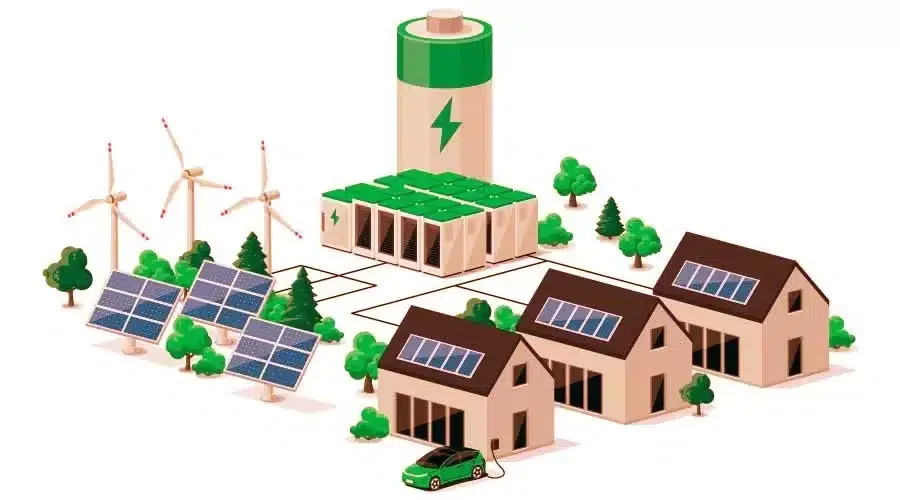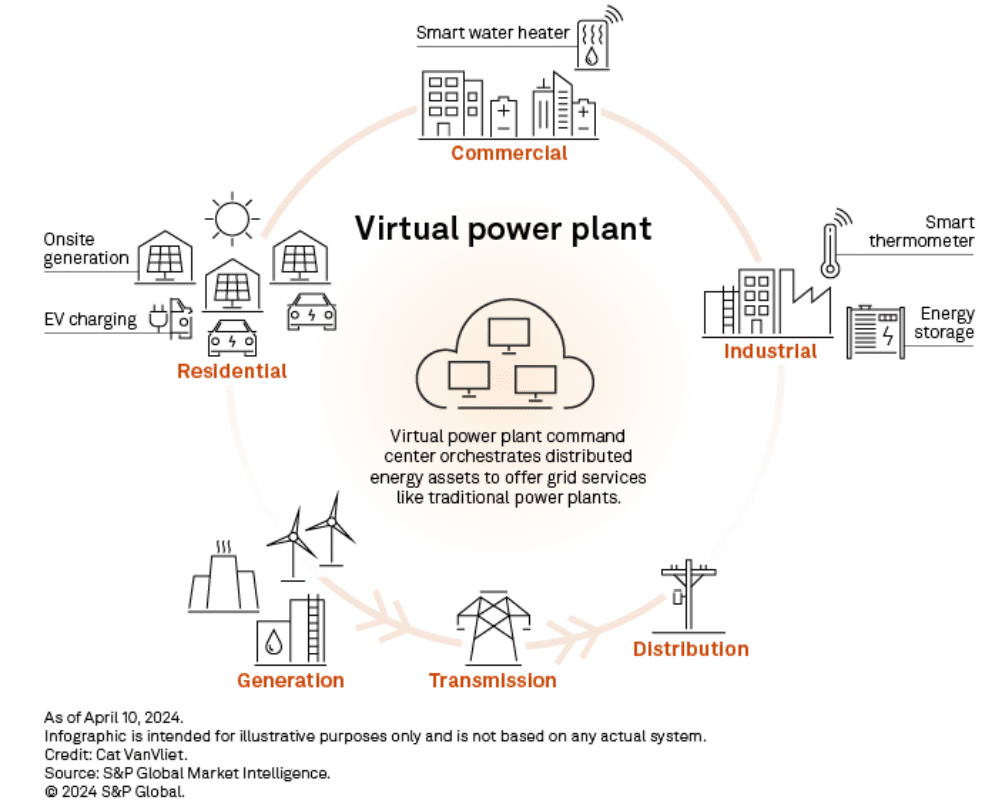California is considering a mandate for virtual power plants (VPPs), with a potential capacity of 7.7 gigawatts by 2035. A recent report by The Brattle Group for GridLab highlights the potential of VPPs to cover about 15% of California’s peak power demand by the same period.
The report identifies various sources contributing to the VPP market potential, including orchestrated electric vehicles (EVs), behind-the-meter batteries, smart thermostats, water heaters, and demand response. These resources could significantly boost VPP capacity, especially from batteries behind residential or commercial meters and managed EV charging.
What is a Virtual Power Plant?
A Virtual Power Plant (VPP) is a network of decentralized, medium-scale power generating units, flexible power consumers, and storage systems. These units are aggregated and coordinated through advanced software and control systems to operate as a single, integrated power resource.
A VPP aims to optimize energy generation, consumption, and storage in real time to meet demand, stabilize the grid, and maximize efficiency. By leveraging distributed energy resources, VPPs offer a flexible and responsive approach to managing electricity supply and demand, enhancing grid reliability, and supporting the integration of renewable energy sources.
Energy experts assert that VPPs are crucial for diminishing the power sector’s reliance on environmentally harmful fossil fuels as the country transitions towards electrifying transportation, buildings, and industrial sectors. While still in the early stages, VPPs are positioned for significant expansion in the United States in the forthcoming years.
Thanks to by President Joe Biden’s recent climate legislation, which incorporates incentives for electric vehicles, solar panels, and home batteries.
However, overcoming barriers to mass VPP deployment may require new policies. Senate Bill 1305 aims to accelerate VPP rollout by directing regulatory bodies, including the following:
- California Public Utilities Commission (PUC),
- California Energy Commission (CEC), and
- California ISO to take actions supporting VPP deployment.
The bill includes provisions for PUC adoption of VPP procurement requirements for investor-owned utilities. The effectiveness of such a mandate hinges on policy details and enforcement mechanisms.
Legislation Propels California’s VPP Evolution
SB 1305 also tasks the CEC and CAISO with estimating the potential of “resource adequacy-qualifying virtual power plant resources” and addressing regulatory barriers.
This initiative builds upon California’s existing goal of achieving 7 GW of flexible demand by 2030. This aim is set to reduce consumer electricity demand during grid stress periods.
The Brattle Group’s assessment reveals that batteries installed at homes and businesses, often coupled with rooftop solar arrays, hold the highest potential for inclusion in software-steered Virtual Power Plants (VPPs).
By 2035, these batteries could cover 5.1% of California’s peak power demand. Synchronized smart thermostats follow closely, offering 4.3%, while managed EV charging, automated demand response, and grid-interactive water heating contribute 3%, 2.3%, and 0.5%, respectively.
The projected 7.7 GW of VPP market potential from these technologies could yield significant savings by 2035. A staggering amount of over $750 million per year could be avoided in traditional system infrastructure investments. Approximately $550 million of these savings would directly benefit consumers.
Realizing the Benefits of VPPs for All Californians
Edson Perez, California lead at Advanced Energy United, emphasizes the tangible benefits of VPPs for Californians, saying that:
“Virtual power plants offer a very real opportunity for Californians to get paid back directly for helping keep the lights on in communities across the state.”
Accessible VPP technologies like smart thermostats and electric vehicles offer residents payments for their participation, he further noted. This would lead to more affordable rates and increased grid resiliency for all ratepayers.
To realize these benefits, the report suggests California adopt emerging best practices for VPPs, drawing from experiences globally. While pilot projects have provided valuable lessons, the focus now must shift to full-scale deployment.
Regulators are also encouraged to ensure that successful pilot programs transition into broader implementation. Additionally, the report recommends providing sufficient incentives to encourage consumer participation in VPPs and support utilities or third-party aggregators in implementing and operating them.
Current payment structures may not fully reflect the value of VPP participation, requiring performance-based incentives for utilities and aggregators. Third-party aggregators could be incentivized with better access to wholesale markets and opportunities to participate in distribution investment deferral programs, among other strategies.
This interesting development comes handy as California faces a challenging task to meet its climate goals. The state must almost triple its efforts in reducing annual emissions to achieve its 2030 target.
Virtual Power Plants represent a crucial step towards a more flexible, efficient, and sustainable energy future. They offer tangible consumer benefits, grid reliability, and the integration of renewable energy sources. Policy initiatives like SB 1305 signal a commitment to accelerating VPP deployment, paving the way for a cleaner energy landscape.


